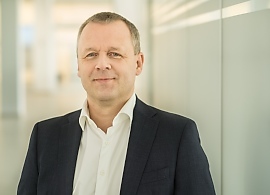The European Commission (EC) has approved Fresenius Kabi’s tocilizumab biosimilar Tyenne®*. It is the first tocilizumab biosimilar approved by the EC and Fresenius Kabi’s third approved biosimilar in Europe. This approval is another crucial milestone in the company’s Vision 2026 growth strategy.
* Tyenne® (tocilizumab) is a registered trademark of Fresenius Kabi Deutschland GmbH in selected countries.
The rate of change, a key parameter for determining the price increase for the reimbursement of hospital treatments in 2024 in Germany, has been set at 4.22%. Due to cost inflation, the rate of change will most likely mark the lower limit of the price increase for hospital treatments for 2024 in Germany. The change in hospital costs is the other parameter used in the annual determination of the reimbursement increase. The final DRG inflator should be determined at the latest by the end of the year.
The rate of change, a key parameter for determining the price increase for the reimbursement of hospital treatments in 2024 in Germany, has been set at 4.22%. Due to cost inflation, the rate of change will most likely mark the lower limit of the price increase for hospital treatments for 2024 in Germany. The change in hospital costs is the other parameter used in the annual determination of the reimbursement increase. The final DRG inflator should be determined at the latest by the end of the year.
Fresenius Kabi announced today it has signed an agreement with Virginia Oncology Associates (VOA) under which VOA will purchase the Ivenix Infusion System to deliver medications for its patients. VOA specializes in treating people with cancer and blood disorders. It is part of the national US Oncology network.
Fresenius Kabi and VOA have agreed to work together to integrate the Ivenix Infusion System with VOA’s electronic medical record (EMR) system.
Fresenius Kabi announced today it has signed an agreement with Virginia Oncology Associates (VOA) under which VOA will purchase the Ivenix Infusion System to deliver medications for its patients. VOA specializes in treating people with cancer and blood disorders. It is part of the national US Oncology network.
Fresenius Kabi and VOA have agreed to work together to integrate the Ivenix Infusion System with VOA’s electronic medical record (EMR) system.
Baader Investment Conference
- Robert Möller appointed to the Fresenius Management Board; at the same time, Möller will assume responsibility for hospital group as CEO of Helios Health GmbH
- Dr. Francesco De Meo leaves the company
- Management Board team continues to drive forward transformation on the way to #FutureFresenius
The Supervisory Board of Fresenius Management SE has appointed Robert Möller (56) to the Management Board with immediate effect. At the same time, he will take over as Chairman of the Management Board of Helios Health GmbH. He succeeds Dr. Francesco de Meo (59), who will leave the company.
Robert Möller has been CEO of Helios Kliniken GmbH since 2022. He joined Helios in 2014, where he held the position of Clinic Managing Director at Helios Hanseklinikum Stralsund until 2017. After a short time away, he returned to Helios in 2019 and took over the management of various regions. Möller studied human medicine at the University of Hamburg and practiced as a specialist for internal medicine. After various medical positions and a part-time master's degree in health care management, he switched to hospital management while continuing to work as a physician.
"Robert Möller, a physician and proven hospital manager from within the company will now move up to the Management Board. His experience is an excellent addition to the management team. With the further development of the hospital business, he will make an important contribution on the successfully chosen path to #FutureFresenius," said Wolfgang Kirsch, Chairman of the Supervisory Board of Fresenius.
"Today, Fresenius is a company with a clear focus and clear responsibilities. We will continue to work together to execute our #FutureFresenius strategy and are well positioned to deliver. Robert Möller addresses the future of healthcare like almost no one else – with a clear focus on digitalization, sustainability and quality. At Helios, he will build on and drive the momentum we have generated so far with #FutureFresenius," said Fresenius CEO Michael Sen.
Helios is Europe's leading private healthcare provider, with approximately 126,000 employees. Together with Quirónsalud in Spain and Latin America and the Eugin Group with a global network of reproductive clinics, Helios Group in Germany is part of the holding Helios Health. With more than 24 million patients per year, the company generated total sales of around 11.7 billion euros in 2022.
This release contains forward-looking statements that are subject to various risks and uncertainties. Future results could differ materially from those described in these forward-looking statements due to certain factors, e.g. changes in business, economic and competitive conditions, regulatory reforms, results of clinical trials, foreign exchange rate fluctuations, uncertainties in litigation or investigative proceedings, the availability of financing and unforeseen impacts of international conflicts. Fresenius does not undertake any responsibility to update the forward-looking statements in this release.
Fresenius SE & Co. KGaA
Registered Office: Bad Homburg, Germany / Commercial Register: Amtsgericht Bad Homburg, HRB 11852
Chairman of the Supervisory Board: Wolfgang Kirsch
General Partner: Fresenius Management SE
Registered Office: Bad Homburg, Germany / Commercial Register: Amtsgericht Bad Homburg, HRB 11673
Management Board: Michael Sen (Chairman), Pierluigi Antonelli, Dr. Sebastian Biedenkopf, Helen Giza, Sara Hennicken, Robert Möller, Dr. Michael Moser
Chairman of the Supervisory Board: Wolfgang Kirsch


